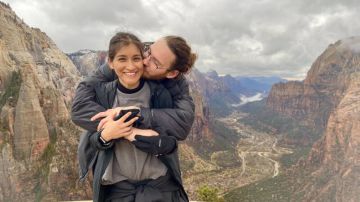The Anxieties of Introducing my Mexican Family to my Non-Latinx Partner
On a weekday afternoon during the summer of 2022 mom, two of my sisters, and I were cooling down outside chismeando

Photo courtesy of Jessica Montes
On a weekday afternoon during the summer of 2022 mom, two of my sisters, and I were cooling down outside chismeando. The warm breeze fanned our skin but I was still sweating. My heart thumped in my chest, my palms wouldn’t stay dry, and my breathing was short. Not because of the weather, but because today, I would tell them about my white boyfriend, David. I grew up in a Mexican household in Southeast Los Angeles, a predominately Latinx area. Here, most of our neighbors, friends, teachers, retail store employees, and coworkers shared our culture and languages. The city reflected my family and one could go months, or even years, without interacting with someone from another race. This absence of racial and ethnic intermingling was reflected in my relatives’ dating histories as well.
For the most part my family, and extended family, have always dated within the ethnicity and only had Mexican partners. Their partners could switch between Spanish and English with ease. Their partners grew up eating pozole and tamales and listening to Joan Sebastian and Los Ángeles Azules.
I was nervous about bringing home someone without knowledge of or a connection to this upbringing. Would they still accept him despite his differences? More than anything, the language barrier was concerning. While my sisters and mom speak English and Spanish, my dad and a few other family members only speak Spanish. Would David’s two years of practice be enough for keeping up with native speakers? Would they judge him for his emerging language skills?
In retrospect, these anxious thoughts reflected my limitations. Based on our community’s demographics, I assumed they were not as open or welcoming of other cultures and races. I anticipated rejection and disapproval without considering if they, like I, had developed an acceptance of all races, ethnicities, and nationalities despite growing up in a homogenous city.
The nerves also reflected that I hadn’t brought anyone home to meet my family in six years and aside from mom half-jokingly asking “¿Y tienes novio?” (And do you have a boyfriend?), I did not discuss dating with them. Typically, my sisters and I follow an indirect introduction for partners. Someone brings home a “friend” one day. This friend becomes a regular at birthdays, holidays, and Sunday carne asadas. Without ever confirming it, and following Juan Gabriel’s “lo que se ve no se pregunta” (loosely: you do not ask about what you can already see) approach, we welcome the new partner.
I wanted to be direct with them, so, as my heart beat in my throat, I said, “I have an announcement.”
All eyes met mine with curiosity. “What is it?” my older sister asked.
“I have a boyfriend.”
Slowly, they processed the information and smiled, sharing congratulations on my new relationship. Quickly, the questions came. What was his name? What did he do? What was he like?
I told them about David’s work as a composer, his love of the outdoors, and, like me, his vegan lifestyle. Emboldened, I tested the waters by revealing his upbringing. While he had lived in Los Angeles for three years, he was from Ohio. The midwestern origins didn’t cause any reaction so I ended with a quick, “Also… he’s white.”
After a second, Mom tilted her head and asked “Pero, ¿es Latino?”
“No, es Americano. He’s white,” I repeated.
Their faces did not reveal anything as the congratulations continued and they shared their excitement to meet him. Later that night at my apartment, I called David and relayed the events. He was equally interested in being introduced and we set a day to go over to Mom’s place.
David and I decided we would introduce him in phases. I figured bringing him as a show-and-tell piece to the usual crew of my parents, three sisters, two nieces, my sister’s boyfriend, two cousins, aunt, and uncle, might be overwhelming. Since my mom and younger sister live together, I began with them.
Before this, mom had asked to see a picture. It showed his long, golden brown hair, glasses, and nose piercing. She exhaled softly. “I thought he would look more serious. Maybe with short hair and a tie. I was worried he would be too serious and I wouldn’t be able to joke around.”
I laughed at her honesty, felt comforted knowing I was not the only one with worries, and eased her concerns. “No, mom. He makes a lot of jokes and he’s really calm. I told him I get my personality from you so he has an idea of how you are. He also never wears ties.”
What the picture couldn’t show was that, due to his Germanic ancestry, he is 6 feet, 7 inches tall! Nothing could have prepared my five-foot mom for meeting someone the same height as a door frame. Her first words upon seeing him were “Wow, you are so tall!”
That afternoon, mom, my sister, and David became acquainted through Spanglish. Mom used her mastery of English from living in the United States for over 35 years and David relied on his two years of studying Spanish. What was not communicated through one language was explained through the other.
He made mom crack up laughing, a beautiful sound I had not heard in years when he shared one of his favorite phrases: “Me vale.” (I don’t care)
While sharing stories and having our fill of soy ceviche, a figure emerging in the distance made three of us freeze. Walking towards the table was my dad. I cursed internally because, as a planner, this was not the day’s itinerary. I cursed again because, unlike mom and my sisters, dad didn’t know I had a boyfriend. He had not been debriefed and was unprepared for who he stumbled upon.
Dad looked at the fourth seat and nodded. I introduced them as casually as possible but my nerves were already activated. With his nose ring, a full sleeve of tattoos, and hair down to his ribs, David blends in with any millennial crowd. However, these same traits challenge the traditional beliefs held by dad.
I put off telling him because I was most worried about his judgment. Dad grew up in Mexico during the ’60s with traditional notions of male and female roles and appearances. He dislikes tattoos and piercings and thinks women should have long hair and men should have short hair. How was I supposed to present David who defied both beliefs?
Yet, his surprise visit meant I must reveal the news much sooner. Dad is a man of few words and this was true for the duration of lunch. Unlike Mom, he’s not fluent in English and understands more than he speaks. He mostly nodded along as the four of us carried the conversations.
As Mom and I began a separate chat, I heard another sound that I do not encounter often: Dad asked David a question in English. My ears perked. I always communicated with him in Spanish and was unaware of his conversational abilities. He and David spoke in short phrases, but they understood one another.
My heart beamed. Instead of ignoring David or showing his displeasure, which I feared would be his reaction, Dad was actually trying. He was looking past the cultural, racial, and linguistic differences. He was looking past the colorful artwork on his arms, the Rapunzelesque tresses, the facial piercing, and treating him like a regular person.
When the sun set, we said goodbye and Mom’s bright demeanor was all the approval I needed. She said David was welcome anytime and hugged us both. That month David met the rest of my family and got along with them thanks to his easy-going, humorous nature.
After the introductions, I felt at ease. Any doubts of whether they would accept him at birthdays, holidays, and Sunday carne asadas were erased. Mom’s advice put all hesitations to rest. “It doesn’t matter what he looks like or where he comes from. If he makes you happy and respects you, we will like him.”

















